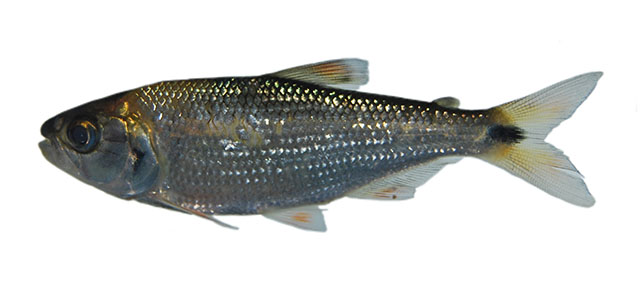| Characidae (Characins; tetras), subfamily: Stevardiinae |
| 16.8 cm SL (male/unsexed) |
|
benthopelagic; freshwater |
| South America: known from the río Pastaza, río Marañon drainage, and upper río Amazonas basin, Ecuador. |
|
Dorsal soft rays (total): 8-8; Anal soft rays: 24-28; Vertebrae: 40-43. This species is distinguished from most of its congeners by the number of branched anal-fin rays (24-28 vs. 15-24 or 28-34); differs from species sharing similar lateral line counts in the following: from H. boquiae by the number of scale rows above and below lateral line (8 and 6 vs. 6-7 and 4-5 respectively), and by the number of predorsal scales (15-17 vs. 12-15); from H. brevispini and H. cairoense by the number of scale rows above lateral line (8 vs. 6-7); from H. dariensis, H. divisorensis, H. surinamensis and H. taeniurus by the number of lateral line scales (42-45 vs. 39-42); from H. huambonicus by the number of caudal peduncle scales (16 vs. 18-20), head length (20.9-22.9 vs. 22.0-26.0% SL), and upper jaw length (43.7-45.6 vs. 45.2-52.6% HL); from H. inambari by the number of scales along anal-fin base scale sheath (14-23 vs. 6-10); from H. jabonero by the number of caudal peduncle scales (16 vs. 14), and number of scale rows below lateral line (6 vs. 4-5); from H. jelskii by the number of maxillary teeth (7-10 vs. 8-17), and by the size of humeral spot (6-7 vs. 7-9 horizontal series of scales); from H. metae by the number of cusps of second tooth of premaxillary inner row teeth (5 vs. 7), caudal peduncle length (14.4-16.6 vs. 11.1-14.8% SL), and head length (20.9-22.9 vs. 22.1-25.0% SL); from H. quindos by the number of scale rows above and below of lateral line (8 and 6 vs. 6-7 and 4-5); from H. rafaelense by the number of predorsal scales (15-17 vs. 10-13), orbital diameter (29.5-34.1 vs. 36.6-43.6% HL), and interorbital width (32.1-35.3 vs. 34.7-41.5% HL); from H. raqueliae and H. yacopiae by the number of predorsal scales (15-17 vs. 10-14), and by the number of cusps of first maxillary tooth (3 vs. 5 in H. raqueliae); from H. surinamensis and H. divisorensis by the absence of a wide black asymmetrical spot covering base of caudal-fin rays; H. dariensis by the absence of pigment in the distal tip of rays just above and below to middle caudal-fin rays (Ref. 85819). |
|
|
Least Concern (LC); Date assessed: 08 October 2014 Ref. (130435)
|
| harmless |
Source and more info: www.fishbase.org. For personal, classroom, and other internal use only. Not for publication.

